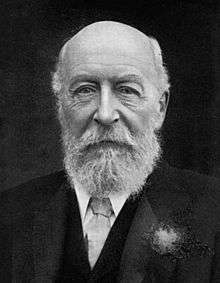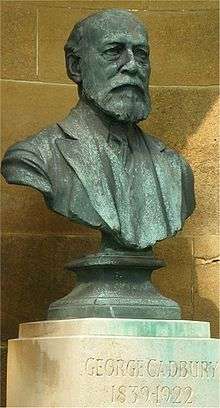George Cadbury
George Cadbury (19 September 1839 – 24 October 1922) was the third son of John Cadbury, a Quaker who founded Cadbury's cocoa and chocolate company in Britain.
George Cadbury | |
|---|---|
 George Cadbury, aged 78 | |
| Born | 19 September 1839 |
| Died | 24 October 1922 (aged 83) Northfield Manor House, Northfield, Birmingham, England |
| Occupation | Founder of Cadbury's |
| Spouse(s) | Mary Tylor (m. 1872; died 1887) |
| Children | 11, including: Edward Cadbury Egbert Cadbury Marion Greeves |
| Relatives | Richard Cadbury (brother) |

Background
He worked at the school for adults on Sundays for no pay, despite only going to school himself until he was fifteen.[1] Together with his brother Richard he took over the family business in 1861. In 1878 they acquired 14 acres (57,000 m²) of land in open country, four miles (6 km) south of Birmingham, where they opened a new factory in 1879. He rented 'Woodbrooke' - a Georgian style mansion built by Josiah Mason, which he eventually bought in 1881.
In the early 20th century, he and John Wilhelm Rowntree established a Quaker study centre in the building,[2] and it remains the only such centre in Europe today, offering short educational courses on spiritual and social matters to Quakers and others. He also created a hospital in Normandy called "l'hopital de Normandy".
The Cadbury brothers were concerned with the quality of life of their employees and provided an alternative to grimy city life. As more land was acquired and the brothers moved the factory to a new country location, they decided to build a factory town (designed by architect William Alexander Harvey), which was not exclusive to the employees of the factory. This village became known as Bournville after the nearby river and French word for "town". The houses were never privately owned, and their value stayed low and affordable. Bournville was a marked change from the poor living conditions of the urban environment. Here, families had houses with yards, gardens, and fresh air. To the present, the town offers affordable housing.
The brothers cared for their employees; they both believed in the social rights of the workers and hence they installed canteens and sport grounds. Nineteen years after brother Richard died, George opened a works committee for each gender which discussed proposals for improving the firm. He also pressed ahead with other ideas, like an annuity, a deposit account and education facilities for every employee.
In 1901, disgusted by the imperialistic policy of the Balfour government and opposed to the Boer War, Cadbury bought the Daily News and used the paper to campaign for old age pensions and against the war and sweatshop labour.[3]
George Cadbury was one of the prime movers in setting up The Birmingham Civic Society in 1918. Cadbury donated the Lickey Hills Country Park to the people of Birmingham. He also donated a large house in Northfield to the Birmingham Cripples Union that was used as a hospital from 1909. It is now called the Royal Orthopaedic Hospital.[4] In 1890 he, along with a number of other leading Quakers, helped re-establish Grove House School as Leighton Park School in Reading as the leading Quaker school in Britain.
He died at his home, Northfield Manor House, on 24 October 1922, aged 83.
Family life
George Cadbury married twice. In 1872 he married Mary Tylor, daughter of Quaker author Charles Tylor:[5] she died in 1887. She was the mother of George Jr, Mary Isabel, Edward, Henry, and Eleanor Cadbury.
In 1888 he married Elizabeth Mary Taylor. They had six children together: Laurence John, George Norman, Elsie Dorothea, Egbert, Marion Janet, and Ursula.

Legacy
The George Cadbury Carillon School was opened in 2006 and is the only carillon school in the United Kingdom.[6]
Biography
- Walter Stranz: George Cadbury (Shire Publications, Aylesbury, 1973) ISBN 0-85263-236-3
- Claus Bernet (2008). "George Cadbury". In Bautz, Traugott (ed.). Biographisch-Bibliographisches Kirchenlexikon (BBKL) (in German). 29. Nordhausen: Bautz. cols. 257–261. ISBN 978-3-88309-452-6.
References
- The Garden City: The Official Organ of the Garden City Association. Garden City Association.
- Thomas C. Kennedy (2001). British Quakerism, 1860–1920: the transformation of a religious community. Oxford University Press. pp. 177–78. ISBN 0-19-827035-6.
- Kevin Grant (2005). A civilised savagery: Britain and the new slaveries in Africa, 1884–1926. Routledge. p. 110. ISBN 0-415-94901-7.
- "Royal Orthopaedic Hospital". Rossbret Institutions Website. Archived from the original on 5 July 2009. Retrieved 3 October 2009.
- David J. Jeremy (1990). Capitalists and Christians: business leaders and the churches in Britain, 1900–1960. Clarendon Press. p. 100. ISBN 0-19-820121-4.
- "Carillon Summer series". Indiana State University. 2008. Archived from the original on 4 May 2010. Retrieved 2 December 2009.
External links
| Wikimedia Commons has media related to George Cadbury. |